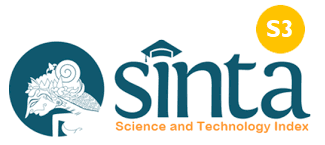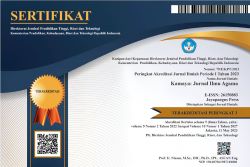Konsistensi Perubahan Bunyi Morfem Dalam Bahasa Jawa
DOI:
https://doi.org/10.37329/kamaya.v8i2.3913Keywords:
perubahan bunyi, bahasa jawa, morfemAbstract
This study aims to describe the forms and background of morpheme sound changes in Javanese. This research is a descriptive qualitative study. The data in this article consists of lexicons or vocabulary found in everyday Javanese speech. The data source for this study comes from the Javanese community in Surakarta. The subject selection technique was purposive sampling. Data collection was conducted using listening and note-taking techniques. Data validity was tested using theoretical triangulation and source triangulation. Meanwhile, the data analysis technique used was the Spradley model. The Spradley model consists of four stages: domain analysis, taxonomic analysis, componential analysis, and cultural theme analysis. Based on the data analysis, the following conclusions can be drawn. There are six forms of morpheme sound changes in Javanese, driven by the demands of (1) krama; (2) guru lagu; (3) guru wilangan; (4) literer; (5) jenis seks; (6) informalization of variety.
References
Arifiani, E. (2019). Sistem Perubahan Struktur Silabel dan Netralisasi Vokal dalam Bahasa Sasak Dialek Bayan (System Of Syllable Structure Change And Vocal Neutralization In Sasak Dialect Of Bayan Language). Jalabahasa, 15(1), 36-47.
Devianty, R. (2022). Salah Kaprah Dalam Bahasa Indonesia: Tinjauan Morfofonemik. Eunoia (Jurnal Pendidikan Bahasa Indonesia), 1(1), 84-97.
Djawa, A., & Sampe, M. (2021). Gejala Perubahan Bahasa dalam Bahasa Loli di Kabupaten Sumba Barat. Bianglala Linguistika: Jurnal Linguistik, 9(2), 29-34.
Fathoni, H. (2013). Pembentukan kata dalam bahasa Arab (sebuah analisis morfologis “KTB”). At- Ta'dib, 8(1).
Gani, S. (2019). Kajian teoritis struktur internal bahasa (fonologi, morfologi, sintaksis, dan semantik). A Jamiy: Jurnal Bahasa dan Sastra Arab, 7(1), 1-20.
Hadi, M., & Arifin, T. (2021). Analisis Perubahan Kata Serapan Bahasa Arab Ke dalam Bahasa Jawa Pada Istilah Agama Islam Dalam Al-Qur’an Surat Al-Baqarah Dan Ali ‘Imran. Jurnal Pendidikan BASIS, 5(2).
Kusmana, A., & Triandana, A. (2022, December). Perubahan Fonem Dalam Morfofonemik Bahasa Melayu Jambi di Kecamatan Danau Teluk. In Proceeding International Conference on Malay Identity (Vol. 3, pp. 180-185).
Josiah, U. E., & Udoudom, J. C. (2012). Morphophonemic Analysis of Inflectional Morphemes in English and Ibibio Nouns: Implications for Linguistic Studies. Journal of Education and Learning, 1(2), 72-81.
Laksana, I. K. D. (2021). Proses Morfofonemis dalam Dialek Nusa Penida. International Seminar on Austronesian Languages and Literature IX.
Lathifatussa’diyyah, S., & Umam, K. Asimilasi Perubahan Bunyi Nasal dan Nonnasal pada Bahasa Arab. Translation and Linguistics (Transling), 2(1), 1-8.
Napps, S. E. (1989). Morphemic relationships in the lexicon: Are they distinct from semantic and formal relationships?. Memory & cognition, 17, 729-739.
Wijaya, I. D. P. (2022). Reduplikasi dengan Perubahan Bunyi dalam Bahasa Indonesia. Klitika: Jurnal Ilmiah Pendidikan Bahasa dan Sastra Indonesia, 4(1), 37-41.
Rumilah, S., & Cahyani, I. (2020). Struktur bahasa; pembentukan kata dan morfem sebagai proses morfemis dan morfofonemik dalam bahasa Indonesia. Jurnal Pendidikan Bahasa Indonesia, 8(1), 70-87.
Setiyadi, D. B. P., Haryono, P., & Herawati, N. (2022). Morphophonemics of the Morpheme {N} in the Javanese language. Eurasian Journal of Applied Linguistics, 8(3), 70-82.
Sikome, A. (2015). Kata Kerja Dalam Bahasa Inggris Dan Bahasa Sangir Suatu Analisis Kontrastif. Jurnal Elektronik Fakultas Sastra Universitas Sam Ratulangi, 2(1).
Sundasewu, R. U. (2015). Analisis Kontrastif Perubahan Fonem Pada Proses Reduplikasi Dalam Bahasa Jepang Dan Bahasa Indonesia: Kajian Morfofonemik. Edusentris, 2(2), 190-202.
Downloads
Published
How to Cite
Issue
Section
License
Copyright (c) 2025 Kamaya: Jurnal Ilmu Agama

This work is licensed under a Creative Commons Attribution-ShareAlike 4.0 International License.
An author who publishes in the Kamaya : Jurnal Ilmu Agama agrees to the following terms:
- Author retains the copyright and grants the journal the right of first publication of the work simultaneously licensed under the Creative Commons Attribution-ShareAlike 4.0 License that allows others to share the work with an acknowledgement of the work's authorship and initial publication in this journal
- Author is able to enter into separate, additional contractual arrangements for the non-exclusive distribution of the journal's published version of the work (e.g., post it to an institutional repository or publish it in a book) with the acknowledgement of its initial publication in this journal.
- Author is permitted and encouraged to post his/her work online (e.g., in institutional repositories or on their website) prior to and during the submission process, as it can lead to productive exchanges, as well as earlier and greater citation of the published work (See The Effect of Open Access).
Read more about the Creative Commons Attribution-ShareAlike 4.0 Licence here: https://creativecommons.org/licenses/by-sa/4.0/.





